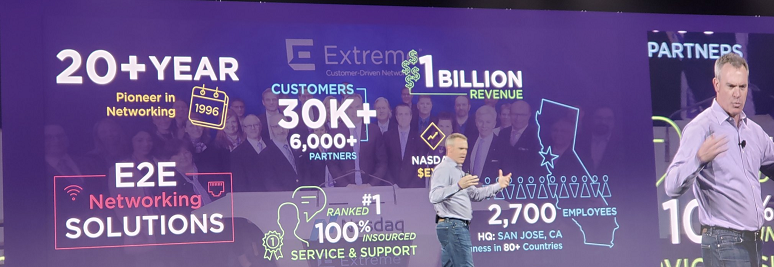Extreme Networks is one of the oldest names in networking, founded in 1996 by
Gordon Stitt, one of the industry’s legendary figures. Since that time,
Extreme has had many ups and downs, and has seen many vendors come and go. This fluctuation and industry turnover makes Extreme one of the more misunderstood network vendors -- so much so that during his opening keynote at this week’s customer event, CEO Ed Meyercord said that when he brings up Extreme to some people, their first reaction is something to the effect of, “I didn’t know they were still in business.”
While Meyercord made that statement jokingly, there is some truth to it. As I noted above, Extreme has gone through a number of lean years when it looked like it might go out of business. And I’ve had a similar experience to the one Meyercord described, being laughed at by financial analysts when I brought up Extreme as a vendor they should look into for purchase or as an investment. But after I explain the state of the company and the transformation it has gone through, ears tend to perk up and people want to learn more.
I’ve had many, many conversations about Extreme and find that unless you’re a hardcore networking insider, you likely don’t know the state of the company. Below are the top five things that most people don’t know about Extreme.
- Extreme is a billion-dollar company -- that’s right. The company that so many people think has gone out of business does about a billion in revenue annually. For FY19, Wall Street estimates show Extreme revenue at $987 million, growing to $1.02 billion in FY20 -- or about two times its revenue in 2014. A number of acquisitions -- including Brocade’s data center business, Avaya’s networking business, and Zebra’s Wi-Fi group (formerly Motorola’s enterprise wireless business) -- has fueled the growth. At about $1 billion, Extreme is actually the largest network pureplay network vendor and is number three in enterprise revenue, behind Cisco and Hewlett Packard Enterprise.
- Extreme has best-in-class service and support -- In the dozens of interviews I’ve done, Extreme customers always rave about the company’s service and support. This wasn’t always the case, as prior to Meyercord’s tenure, the outsourced support organization was actually a liability. But under Meyercord, Extreme decided to insource 100% of the service and support organization, and has seen huge dividends as a result. At the event, Extreme touted its strength in this area by showing stats like 94% of support calls are resolved by the first person who answers -- unheard of in tech support. Also, 99% of people who have reviewed Extreme would recommend the company.
- Extreme is one of only three vendors in the Leaders quadrant of Gartner’s Wired and Wireless LAN MQ -- I believe at last count there were 15 vendors in Gartner’s Wired/WLAN MQ. Of those, only three landed in the Leaders quadrant. To no surprise, Cisco is one of them, as is Aruba, an HPE company. Extreme is the third. Given how crowded this market is, this often comes as the biggest surprise, but the company has done a fantastic job of building a solid portfolio of products. In fact, Extreme is deployed in demanding environments where many vendors won’t even attempt to bid because the requirements are so tough. Examples are Gillette Stadium (home of the six-time Super Bowl champions), Bell Center in Montreal, and the Toronto Metro Center, home to many massive conventions.
- Extreme is a security vendor -- No one is going to confuse Extreme with likes of Palo Alto Networks or Fortinet, but Extreme does have a number of its own security products. One of the most popular is the IoT Defender, which is a simple plug-and-play device that sits in-line between an IoT endpoint and the network. The primary role of the device is to enable companies to secure devices that typically aren’t securable. Extreme also has its network access control product, wireless intrusion prevention, and compliance solutions. There’s more coming as well. During his presentation at ExtremeConnect, EVP of Products Nabil Bukhari gave a preview of a machine learning-based security product that automatically gathers device information, groups the devices logically, and takes action based on anomalies. Given Extreme’s end-to-end portfolio, I would expect to see more innovation in the area of security that can be enabled from the network.
- Extreme is a data center vendor -- Those who are aware of Extreme know the company primarily as a campus network vendor. However, it has a broad set of data center solutions, primarily from the business unit it acquired from Brocade. The strength of its portfolio is the breadth of solutions. It has leaf-spine switches, a Layer 2 fabric, Layer 3 fabric, and core routers. Also, its Workflow Composer application enables cross-domain automation across multivendor networks.
This isn’t your father’s Extreme. This company, whose existence was being questioned just a few years ago, has risen from the proverbial ashes, primarily on the strength of the dynamic duo of Meyercord and Norman Rice, chief marketing, development and product operations officer, coming in and making some shrewd acquisitions. The company has certainly had some bumps along the way, as it’s had to integrate products, development teams, salesforces, back-end systems, channels, and a whole bunch of other stuff but most of that is behind it now.
What’s next? I think Meyercord summed it up nicely in his keynote when he said: “We were the number 13 player and now we have gone all the way to number three, and now we have put number two into our cross hairs.”










